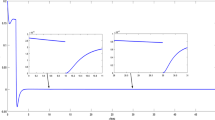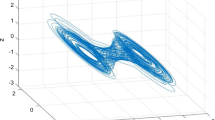Abstract
In this paper, the finite-time control problem is investigated for a class of discrete-time Markovian jump systems (MJLSs) with deterministic switching and time-delay. The considered systems are subject to a piecewise-constant transition probability (TP) matrix, which leads to both the deterministic switches and stochastic jumps. First, the stochastic finite-time boundedness (SFTB) and l 2 gain analysis for the systems are studied by employing the average dwell time (ADT) approach. Note that a finite-time weighted l 2 gain is obtained to measure the disturbance attenuation level. Then, the mode-dependent and variation-dependent controller is designed such that the resulting closed-loop systems are stochastically finite-time bounded and have a guaranteed disturbance attenuation level. Finally, a numerical example is given to verify the potential of the developed results.
Similar content being viewed by others
References
L. V. Costa, M. D. Fragoso, and R. P. Marques, Discrete Time Markovian Jump Linear Systems, Springer, London, 2005.
L. V. Costa, M. D. Fragoso, and M. G. Marques, Continuous-time Markovian Jump Linear Systems, Springer, Berlin, 2013.
L. X. Zhang and E. K. Boukas, “Stability and stabilization of Markovian jump linear systems with partly unknown transition probabilities,” Automatica, vol. 45, no. 2, pp. 463–468, February 2009.
L. X. Zhang and E. K. Boukas, “Mode-dependent H ∞ filtering for discrete-time Markovian jump linear systems with partly unknown transition probabilities,” Automatica, vol. 45, no. 6, pp. 1462–1467, June 2009.
L. X. Zhang and J. Lam, “Necessary and sufficient conditions for analysis and synthesis of Markov jump linear systems with incomplete transition descriptions,” IEEE Trans. on Automatic Control, vol. 55, no.7, pp. 1695–1701, July 2010.
Y. Y. Yin, P. Shi, F. Liu, and K. L. Teo, “Fuzzy model-based robust H ∞ filtering for a class of nonlinear nonhomogeneous Markov jump systems,” Signal Processing, vol. 93, no. 9, pp. 2381–2391, September 2013.
S. P. Ma and E. K. Boukas, “Robust quadratic control of discrete-time singular Markov jump systems with bounded transition probabilities,” Proc. of American Control Conference, pp. 4044–4049, 2009.
M. Shen and G. H. Yang, “New analysis and synthesis conditions for continuous Markov jump linear systems with partly known transition probabilities,” IET Control Theory & Applications, vol. 6, no. 14, pp. 2318–2325, September 2012.
S. Zhao and F. Liu, “State estimation in non-linear Markov jump systems with uncertain switching probabilities,” IET Control Theory & Applications, vol. 6, no. 5, pp. 641–650, March 2012.
X. Luan, P. Shi, and F. Liu, “Finite-time stabilisation for Markov jump systems with Gaussian transition probabilities,” IET Control Theory & Applications, vol. 7, no. 2, pp. 298–304, April 2013.
X. Luan, S. Zhao, and F. Liu, “H ∞ control for discrete-time Markov jump systems with uncertain transition probabilities,” IEEE Trans. on Automatic Control, vol. 5, no. 8, pp. 1566–1572, May 2013.
L. X. Zhang, “H ∞ estimation for discrete-time piecewise homogeneous Markov jump linear systems,” Automatica, vol. 45, no. 11, pp. 2570–2576, November 2009.
Y. C. Ding, H. Zhu, S. M. Zhong, Y. P. Zhang, and Y. Zeng, “H ∞ filtering for a class of piecewise homogeneous Markovian jump nonlinear systems,” Mathematical Problems in Engineering, pp. 1–23, August 2012.
Z. G. Wu, J. H. Park, H. Y. Su, and J. Chu, “Stochastic stability analysis for discrete-time singular Markov jump systems with time-varying delay and piecewise-constant transition probabilities,” Journal of the Franklin Institute, vol. 349, no. 9, pp. 2889–2902, November 2012.
L. J. Chen, Y. Leng, H. F. Guo, P. Shi, and L. X. Zhang, “H ∞ control of a class of discrete-time Markov jump linear systems with piecewiseconstant TPs subject to average dwell time switching,” Journal of the Franklin Institute, vol. 349, no. 6, pp. 1989–2003, August 2012.
P. Bolzern, P. Colaneri, and G. De Nicolao, “Markov jump linear systems with switching transition rates: mean square stability with dwelltime,” Automatica, vol. 46, no. 6, pp. 1081–1088, June 2010.
M. Misas and M. T. Ramirez, “Colombian economic growth under Markov switching regimes with endogenous transition probabilities,” Borradores de Economia, vol. 425, pp. 1–21, December 2006.
T. C. E. Cheng, C. Y. Gao, and H. C. Sheng, “Production and inventory rationing in a Make-to-Stock system with a failure-prone machine and lost sales,” IEEE Trans. on Automatic Control, vol. 56, no. 6, pp. 1176–1180, May 2011.
P. Bolzern, P. Colaneri, and G. De Nicolao, “Almost sure stability of Markov jump linear systems with dwell-time constrained switching dynamics,” Proc. of the 50th IEEE Conference on Decision and Control and European Control Conference, pp. 5461–5466, 2011.
P. Bolzern, P. Colaneri, and G. De Nicolao, “Almost sure stability of Markov jump linear systems with deterministic switching,” IEEE Trans. on Automatic Control, vol. 58, no. 1, pp. 209–214, January 2013.
L. L. Hou, G. D. Zong, and Y. Q. Wu, “Exponential l 2-l ∞ stochastic stability analysis for discrete-time switching Markov jump linear systems,” Proc. of the 30th Chinese Control Conference, pp. 1722–1727, 2011.
F. Amato, M. Ariola, and P. Dorato, “Finite-time control of linear systems subject to parametric uncertainties and disturbances,” Automatica, vol. 37, no. 9, pp. 1459–1463, September 2001.
F. Amato and M. Ariola, “Finite-time control of discrete-time linear systems,” IEEE Trans. on Automatic Control, vol. 50, no. 5, pp. 724–729, May 2005.
E. Moulay, M. Dambrine, N. Yeganefar, and W. Perruquetti, “Finite-time stability and stabilization of time-delay systems,” Systems & Control Letters, vol. 57, no. 7, pp. 561–566, July 2008.
F. Amato, R. Ambrosino, M. Ariola, and C. Cosentino, “Finite-time stability of linear timevarying systems with jumps,” Automatica, vol. 45, no. 5, pp. 1354–1358, May 2009.
F. Amato, M. Ariola, and C. Cosentino, “Finitetime control of discrete-time linear systems: Analysis and design conditions,” Automatica, vol. 46, no. 5, pp. 919–924, May 2010.
F. Amato, R. Ambrosino, C. Cosentino, and G. D. Tommasi, “Input-output finite time stabilization of linear systems,” Automatica, vol. 46, no. 9, pp. 1558–1562, September 2010.
F. Amato, R. Ambrosino, C. Cosentino, and G. D. Tommasi, “Finite-time stabilization of impulsive dynamical linear systems,” Nonlinear Analysis: Hybrid Systems, vol. 5, no. 1, pp. 89–101, February 2011.
X. Z. Lin, H. B. Du, and S. H. Li, “Finite-time boundedness and L2-gain analysis for switched delay systems with norm-bounded disturbance,” Applied Mathematics and Computation, vol. 217, no. 12, pp. 5982–5993, February 2011.
H. Y. Song, L. Yu, D. Zhang, and W. A. Zhang, “Finite-time H ∞ control for a class of discrete-time switched time-delay systems with quantized feedback,” Communications in Nonlinear Science and Numerical Simulation, vol. 17, no. 12, pp. 4802–4814, December 2012.
Z. R. Xiang, Y. N. Sun, and M. S. Mahmoud, “Robust finite-time H ∞ control for a class of uncertain switched neutral systems,” Communications in Nonlinear Science and Numerical Simulation, vol. 17, no.4, pp. 1766–1778, April 2012.
Z. R. Xiang, C. H. Qiao, and M. S. Mahmoud, “Finite-time analysis and H ∞ control for switched stochastic systems,” Journal of the Franklin Institute, vol. 349, no. 3, pp. 915–927, April 2012.
X. Z. Lin, H. B. Du, S. H. Li, and Y. Zou, “Finitetime boundedness and finite-time l2 gain analysis of discrete-time switched linear systems with average dwell time,” Journal of the Franklin Institute, vol. 350, no. 4, pp. 911–928, May 2013.
X. L. Luan, F. Liu, and P. Shi, “Observer-based finite-time stabilization for extended Markov jump systems,” Asian Journal of control, vol. 13, no. 6, pp. 925–935, November 2011.
X. L. Luan, F. Liu, and P. Shi, “Robust finite-time control for a class of extended stochastic switching systems,” International Journal of Systems Science, vol. 42, no. 7, pp. 1197–1205, July 2011.
S. P. He and F. Liu, “Finite-time fuzzy control of nonlinear jump systems with time delays via dynamic observer-based state feedback,” IEEE Trans. on Fuzzy Systems, vol. 20, no. 4, pp. 605–614, August 2012.
S. P. He and F. Liu, “On robust controllability of uncertain non-linear jump systems with respect to the finite-time interval,” Trans. of the Institute of Measurement and Control, vol. 34, no. 7, pp. 841–849, October 2012.
O. L. V. Costa, E. O. A. Filho, E. K. Boukas, and R. P. Marques, “Constrained quadratic state feedback control of discrete-time Markovian jump linear systems,” Automatica, vol. 35, no. 4, pp. 617–626, April 1999.
Author information
Authors and Affiliations
Corresponding author
Additional information
Recommended by Associate Editor Izumi Masubuchi under the direction of Editor Zengqi Sun.
This project is jointly supported by NSFC (61203126), NSFC (61374047), 111 Project (B12018) and self-determined research program of Jiangnan University (JUSRP11233).
Jiwei Wen received his B.E. degree in Industrial Automation from Nantong Institute of Technology, Nantong, China, in 2003 and his Ph.D. degree in Control Science and Control Engineering from Jiangnan University, Wuxi, China, in 2011. Currently, he is an associate professor of School of Internet of Things Engineering, Jiangnan University, Wuxi, China. His research interests include hybrid system, networkbased system, receding horizon control and filtering, fuzzy modeling and control. He is an Associate Editor of the International Journal of Sensors, Wireless Communications and Control.
Li Peng is a professor of the School of IoT Engineering in Jiangnan University in China and a Ph.D. student supervisor. His Ph.D. degree was received from the School of Information Engineering, University of Sci. & Tech. Beijing in 2002. His master degree was got from the Department of Automatic Control, Northeastern University in 1996. His bachelor degree was obtained from Automation department of Hebei Polytechnic University in 1989. Now He is a member of Chinese Computer Association, and also Chinese Artificial Intelligent Association. His research interests are computer simulation, intelligent control and visual wireless sensor network.
Sing Kiong Nguang received his B.E. (with first class honors) and Ph.D. degrees from the Department of Electrical and Computer Engineering of the University of Newcastle, Callaghan, Australia, in 1992 and 1995, respectively. Currently, he is with the Department of Electrical and Computer Engineering, University of Auckland, Auckland, New Zealand. He has published over 200 refereed journal and conference papers on nonlinear control design, nonlinear control systems, nonlinear time-delay systems, nonlinear sampled-data systems, biomedical systems modeling, fuzzy modeling and control, biological systems modeling and control, and food and bioproduct processing. He has/had served on the editorial board of a number of international journals. He is the Chief-Editor of the International Journal of Sensors, Wireless Communications and Control.
Rights and permissions
About this article
Cite this article
Wen, J., Peng, L. & Nguang, S.K. Finite-time control for discrete-time Markovian jump systems with deterministic switching and time-delay. Int. J. Control Autom. Syst. 12, 473–485 (2014). https://doi.org/10.1007/s12555-013-0397-x
Received:
Revised:
Accepted:
Published:
Issue Date:
DOI: https://doi.org/10.1007/s12555-013-0397-x




